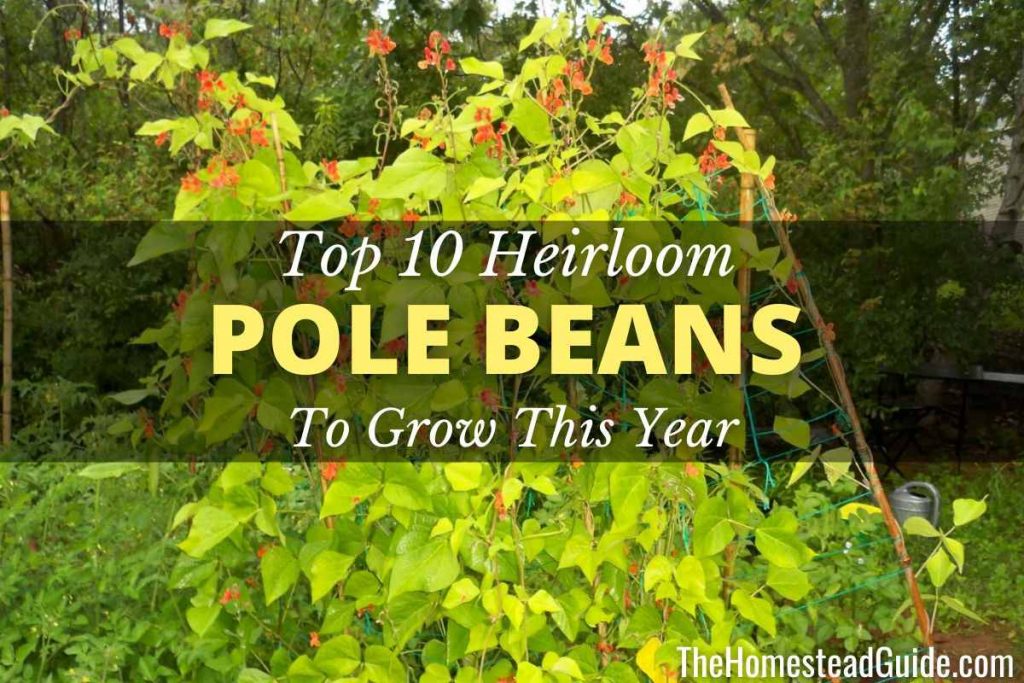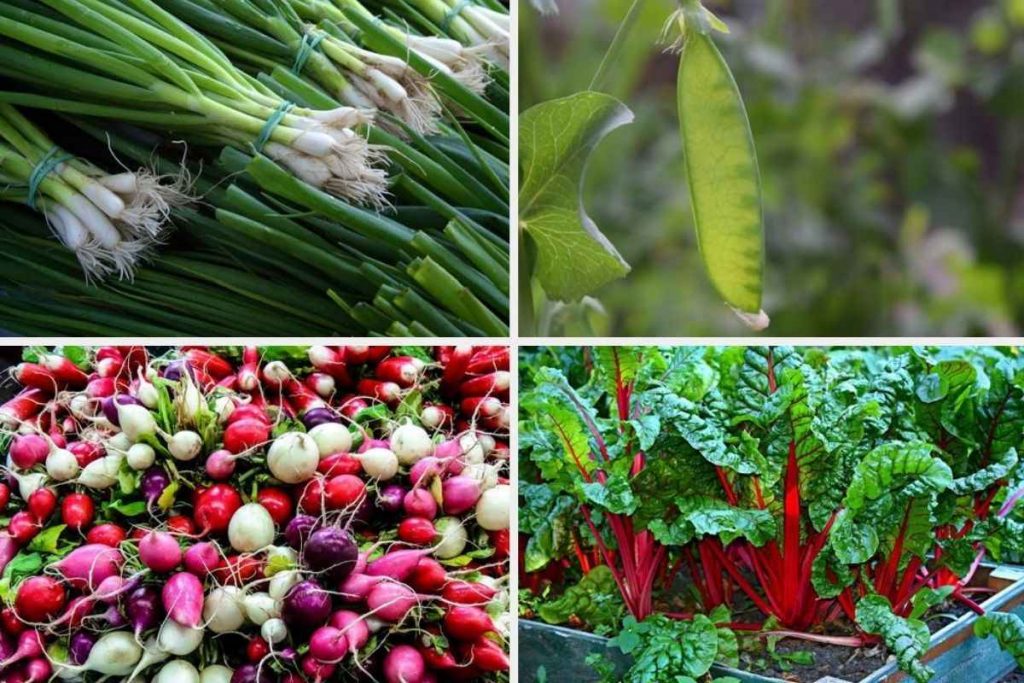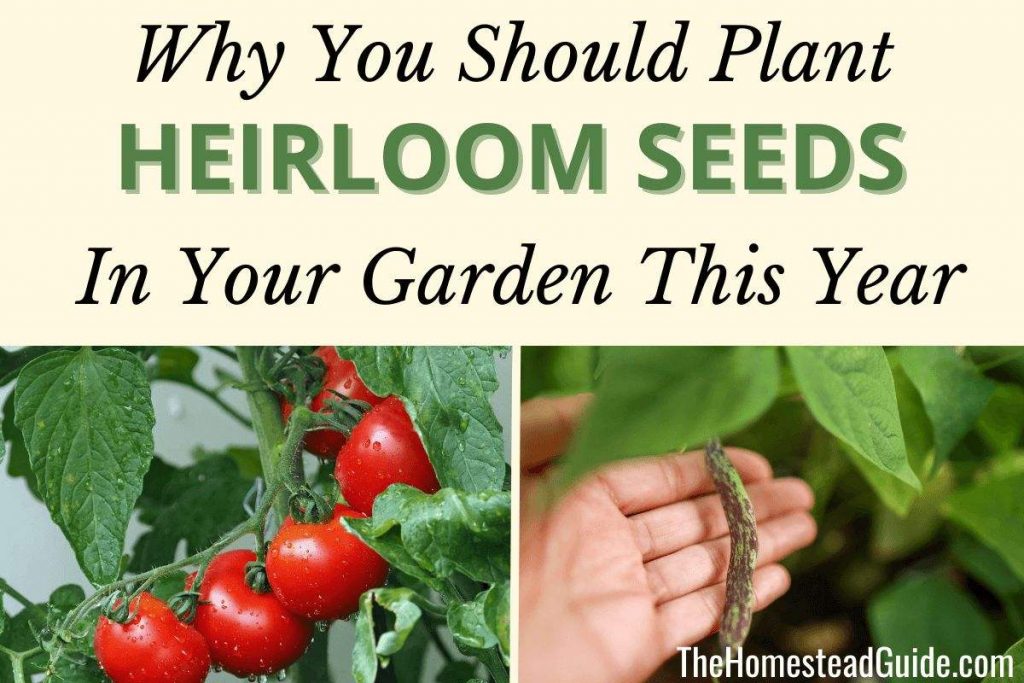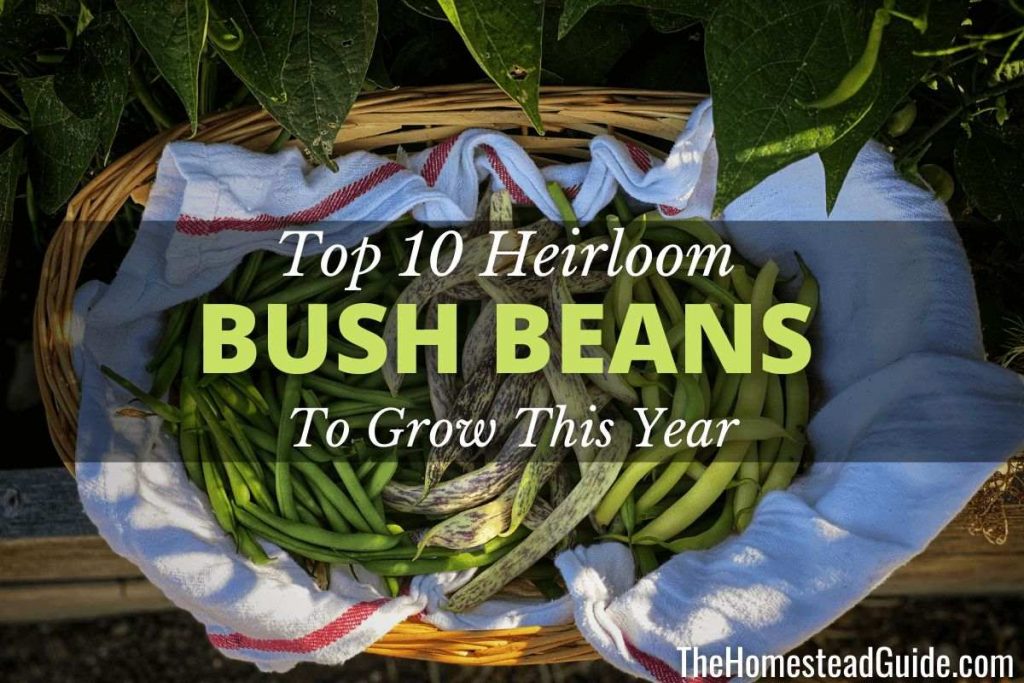Beans are a classic vegetable garden staple. They are so easy to grow and they produce so much for minimal effort! Pole beans grown on a trellis or fence give a beautiful, rustic look to your garden and they produce beans over a longer period of time than bush beans, meaning you don’t have to harvest all your beans at once.
I’ve put together a list of my top 10 favorite heirloom pole beans to grow in your garden this year. There are so many different varieties to choose from, so you’re sure to find the perfect one for your needs, whether you prefer beans for eating fresh, freezing, drying or canning.
First, let’s learn a little bit about the different types of beans and some tips on how to grow them.
- Pole Beans vs. Runner Beans vs. Bush Beans
- Tips for Growing Heirloom Pole Beans
- 1. Blue Lake Pole Bean
- 2. Kentucky Wonder
- 3. Rattlesnake
- 4. Christmas Lima Pole Bean
- 5. Oriental Yard Long Pole Bean
- 6. Scarlet Runner
- 7. King of the Garden Pole Lima
- 8. White Emergo Runner Bean
- 9. Lazy Housewife
- 10. Purple Peacock
- Conclusion
Pole Beans vs. Runner Beans vs. Bush Beans
Beans come in many shapes, sizes, and colors, but they can generally be divided into two main categories: bush beans and pole beans. Bush beans are compact plants that reach an average height of about 18 inches. They produce a large number of beans all at once and do not require any type of support. You can simply sow the seeds directly into the ground, thin them out as they grow, and then harvest the beans when they’re ready.
Pole beans, on the other hand, need some type of support system such as a trellis or fence. They are more vining in nature and can grow up to 15 feet tall. Pole beans produce fewer beans at a time than bush beans, but they yield well over a continuous period of time. They also take longer to mature than bush beans, usually about 2 weeks longer, but once they start producing, pole beans will continue to produce for several weeks to a month. They are slightly hardier than bush beans and a little more disease-resistant, possibly because they get a lot more airflow due to their climbing nature.
Runner beans are also climbing beans, but they are an entirely different species than pole beans. They are commonly enjoyed as ornamentals for their beautiful, vibrant flowers, but their flattened pods are also edible. In fact, one of the most famous heirloom bean varieties in America is the Scarlet Runner with its spectacular fiery red blooms, and its pods are delicious to eat when picked young, or the beans can be dried when the pods reach maturity.
Tips for Growing Heirloom Pole Beans
- Full sun: At least 8 hours a day.
- They are nitrogen fixers: Both pole beans and bush beans are nitrogen fixers, meaning they add nitrogen to the surrounding soil. This makes them excellent companions for a lot of plants including carrots, cucumbers, peas, arugula and spinach. Because they can pull nitrogen from the air, they typically don’t need any extra fertilizer. If you have poor soil, adding some manure or compost before you start planting is always a good idea, though.
- Warm soil: Beans are very sensitive to cold temperatures, so it’s best to direct sow after the last frost date and when the soil has warmed up to at least 68° F (20° C).
- Harvesting dry beans for storing, canning or as seeds: Wait until the bean pods have completely dried and you can hear the beans rattling inside. Shell the beans and, if you prefer, set them somewhere spread out and out of direct sunlight to ensure they are 100% dry before you store them.
1. Blue Lake Pole Bean
This is the pole version of the popular bush bean variety of the same name. They are an early-maturing variety and will produce beans all summer long! These are great heirloom pole beans to grow so that you can enjoy fresh green beans as soon as 50 days in and throughout the summer. The pods can grow 5-6” long, and the beans are great for eating fresh, freezing or canning, but they are widely grown for how well they work with canning.
Days to Maturity: 50-70
Height: 7-12 feet
Best For: Eating fresh, freezing, canning
Available at True Leaf Market.
2. Kentucky Wonder
This is another classic, early-maturing, heirloom pole bean. It looks beautiful on a trellis or fence, and it is a heavy producer with pods reaching up to 9”, so make sure your support system is strong enough to support some weight! Kentucky Wonder is a favorite among many gardeners, and the beans make a great all-purpose variety for eating fresh, freezing or canning. They can also be dried if you let the pods completely mature to full size.
Days to Maturity: 50
Height: 7 feet
Best For: Eating fresh, freezing, canning, drying
Available at Hoss Tools.
3. Rattlesnake
Rattlesnake pole beans are a beautiful purple and green-dappled heirloom variety that is very popular in organic gardens. This is a vigorous producer with vines reaching 10’ tall and pods reaching 6-10” in length, so you’ll definitely want to make sure you have a strong support system for these beans. Rattlesnake beans grow particularly well in hot, humid climates and can handle dry spells. They are great for eating fresh when young and can also be left to mature and shell for drying. I’d personally recommend making sure you pick your beans when they are young if you want to eat them fresh – once they start to get larger, they become very stringy. If you forget to pick your beans in time, cook a few first to test their stringiness, and if it’s too late, leave them on the vine for shelling. I learned this the hard way!
Days to Maturity: 50-70
Height: 10 feet
Best For: Eating fresh, drying
Available at Hoss Tools.
4. Christmas Lima Pole Bean
Christmas Lima beans are a stunning purple and white-marbled pole bean with a rich chestnut texture and a nutty flavor. They are originally from Peru, making them a “true” Lima bean. They are fast-growing and heavy yielding, so make sure your trellis is able to support a hefty bunch of beans! They grow well in a wide variety of climates and are particularly heat tolerant. Christmas Lima beans are easy to shell once matured and are perfect to add to soups and chili.
Days to Maturity: 75
Height: 10 feet
Best For: Drying
Available at Hoss Tools.
5. Oriental Yard Long Pole Bean
I love long beans – they are so unique and so versatile, and they are definitely an eye-catcher in the garden! They are more closely related to black-eyed peas than string beans, but they taste more like string beans with a hint of asparagus. These long, thin pods can grow anywhere between one to three feet long (yes, you read that right), and they make a great low-carb substitute for noodles in stir-fries! They cook up very quickly, so they’re best sautéed or grilled and not steamed or boiled.
Days to Maturity: 85
Height: 8-12 feet
Best For: Eating fresh
Available at True Leaf Market.
6. Scarlet Runner
This famous heirloom runner bean is known for its striking, fiery-red blossoms. These beans grow very fast and very wide – they can sprawl up to 20’ in length! These beans make a beautiful addition to your garden as just an ornamental, but the bonus is that the beans are delicious when picked young! Once the pods become a bit older and tougher, you can shell the still-immature seeds to cook fresh, or you can wait for the pods to mature and dry and harvest the deep red beans for storing.
Days to Maturity: 60-70
Height: Up to 20 feet
Best For: Eating fresh, drying
Available at Hoss Tools.
7. King of the Garden Pole Lima
This is an old-timey favorite that dates back to the late 1800s. These heirloom pole beans grow like crazy and the vines reach 9’ tall with tons of 8” pods. The large white beans have a rich, creamy flavor with a bit of sweetness to them, and they are a favorite because of how vigorous they are and how big of a yield they produce. Definitely a great variety to consider! It is important to note that these beans, like all Lima beans, must be cooked before eating.
Days to Maturity: 90
Height: 9 feet
Best For: Eating fresh (cooked), canning
Available at True Leaf Market.
8. White Emergo Runner Bean
This heirloom variety is similar to the Scarlet Runner, but it has beautiful white flowers instead of orange or red. The flowers, like those on the Scarlet Runner, attract hummingbirds and pollinators, and it makes an excellent ornamental plant as much as it does a crop for you to eat. The long, flat pods are delicious when picked young, and this variety of runner bean is quite hardy under a variety of weather conditions. I’d recommend planting these beans near your snap peas to attract pollinators to the flowers.
Days to Maturity: 80
Height: 10 feet
Best For: Eating fresh, drying, freezing
Available at Hoss Tools.
9. Lazy Housewife
This is another old-timey variety (if you couldn’t tell from its old-school and just slightly sexist name) that dates back to the late 1800s. It was actually the first stringless snap bean introduced in North America, and it got its name due to how easy it was to prepare and cook. It is still a favorite among many gardeners due to its ease of preparation and rich, buttery flavor.
Days to Maturity: 80
Height: 8-9 feet
Best For: Eating fresh, freezing, drying, canning
Available at West Coast Seeds.
10. Purple Peacock
This beautiful heirloom pole bean produces rich purple beans, light purple flowers and lush, dark green leaves. It is great in cool conditions and it flowers early on, attracting beneficial pollinators to your garden and making a beautiful addition to a fence or trellis. The pods are tender and keep producing all summer long. They turn green when cooked and have a delicious sweet and nutty flavor. This is an excellent variety to grow in your garden this year for its looks and its flavor!
Days to Maturity: 70
Height: 6-8 feet
Best For: Eating fresh
Available at West Coast Seeds.
Conclusion
I just love the look of beans growing up a beautiful trellis or fence, don’t you? I feel like it adds a bit of variety to your garden design to have various heights of things.
Looking to grow some bush beans as well? Check out my top 10 recommendations for the best heirloom bush beans to grow.
Bush beans and pole beans also make great companions for cucumbers and peas as well!
What are your favorite heirloom pole bean varieties? Let me know in the comments!
And if you’re looking to get started with homesteading and organic gardening, make sure to check out our Complete Guide to Organic Gardening.





